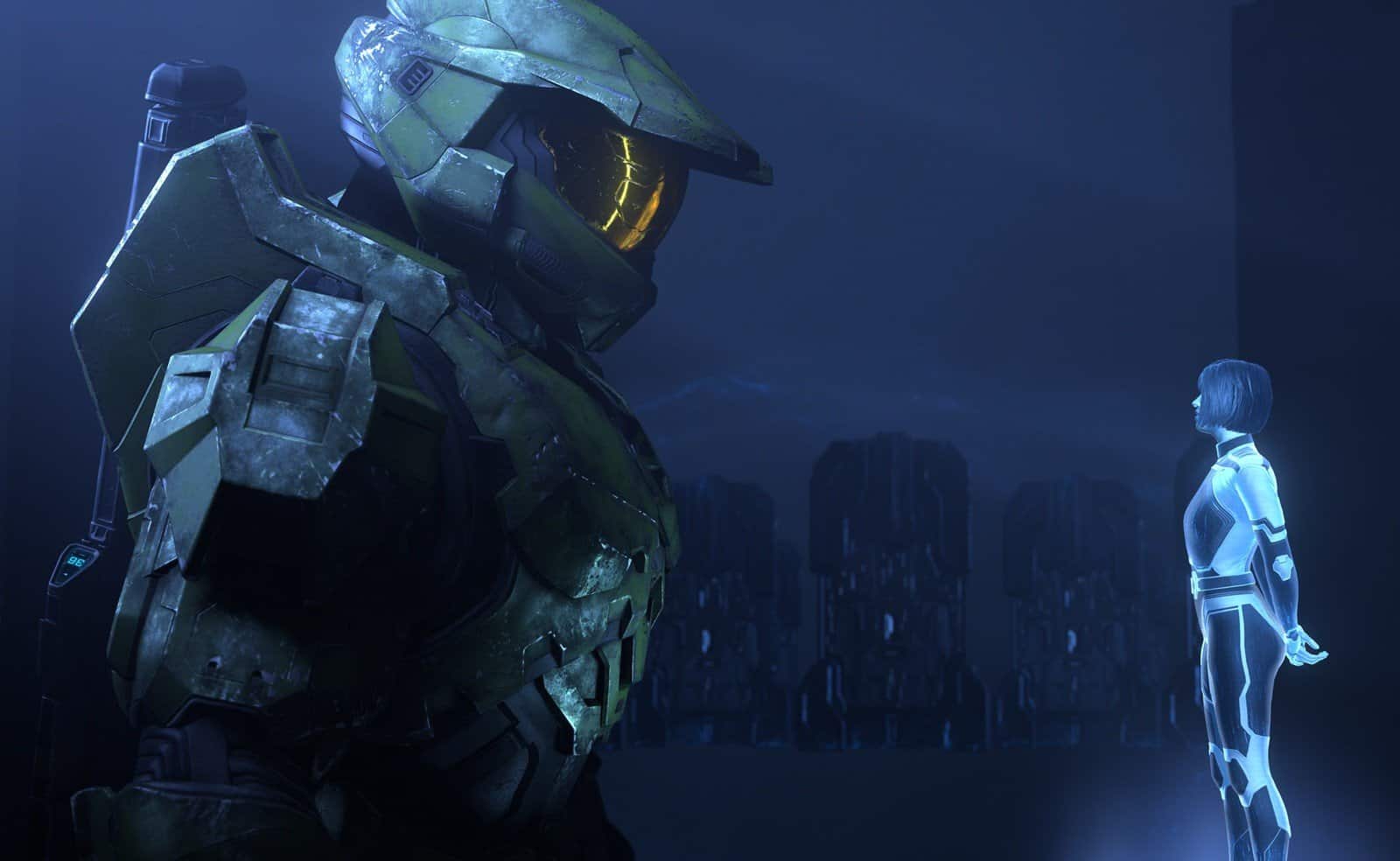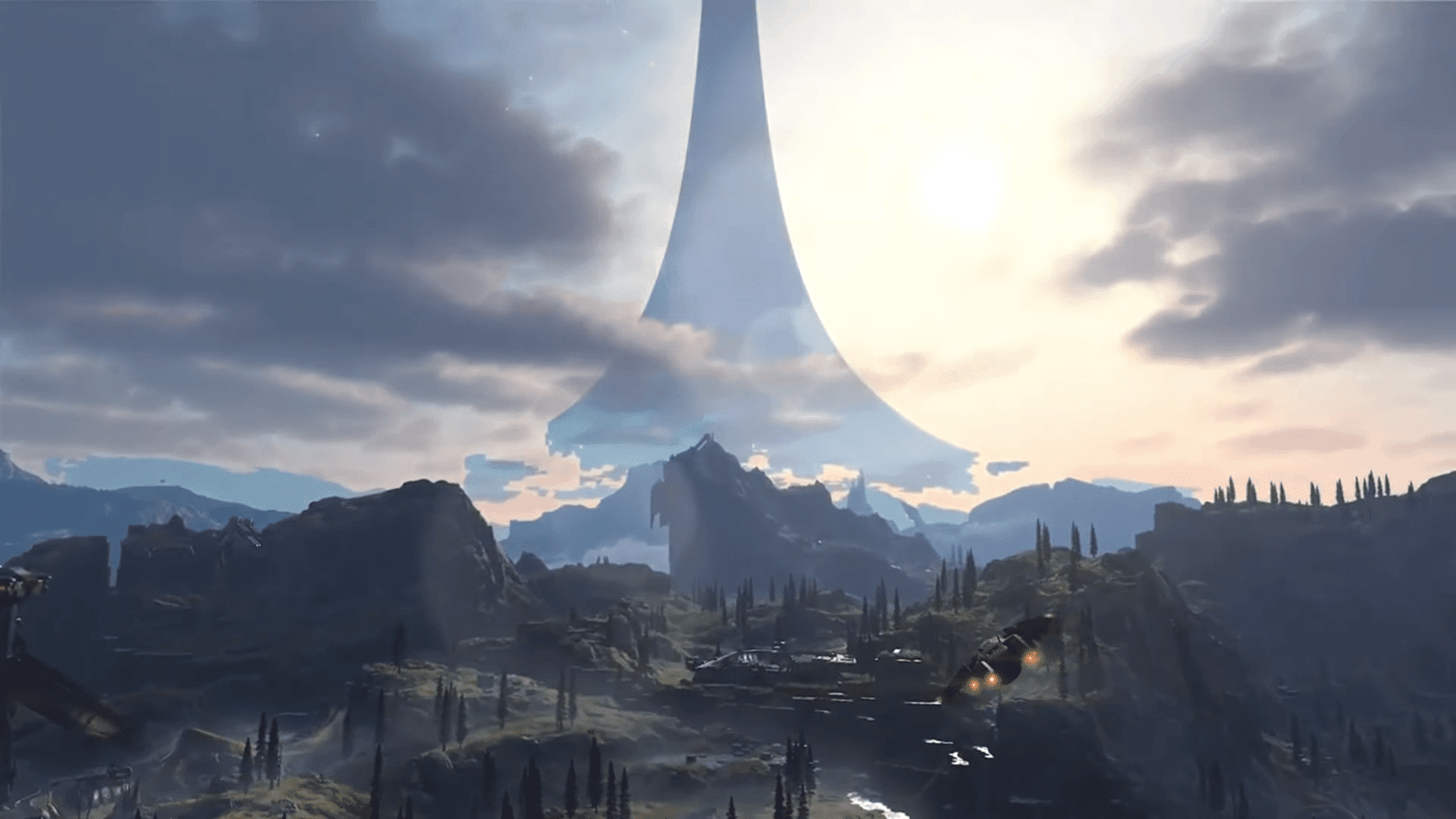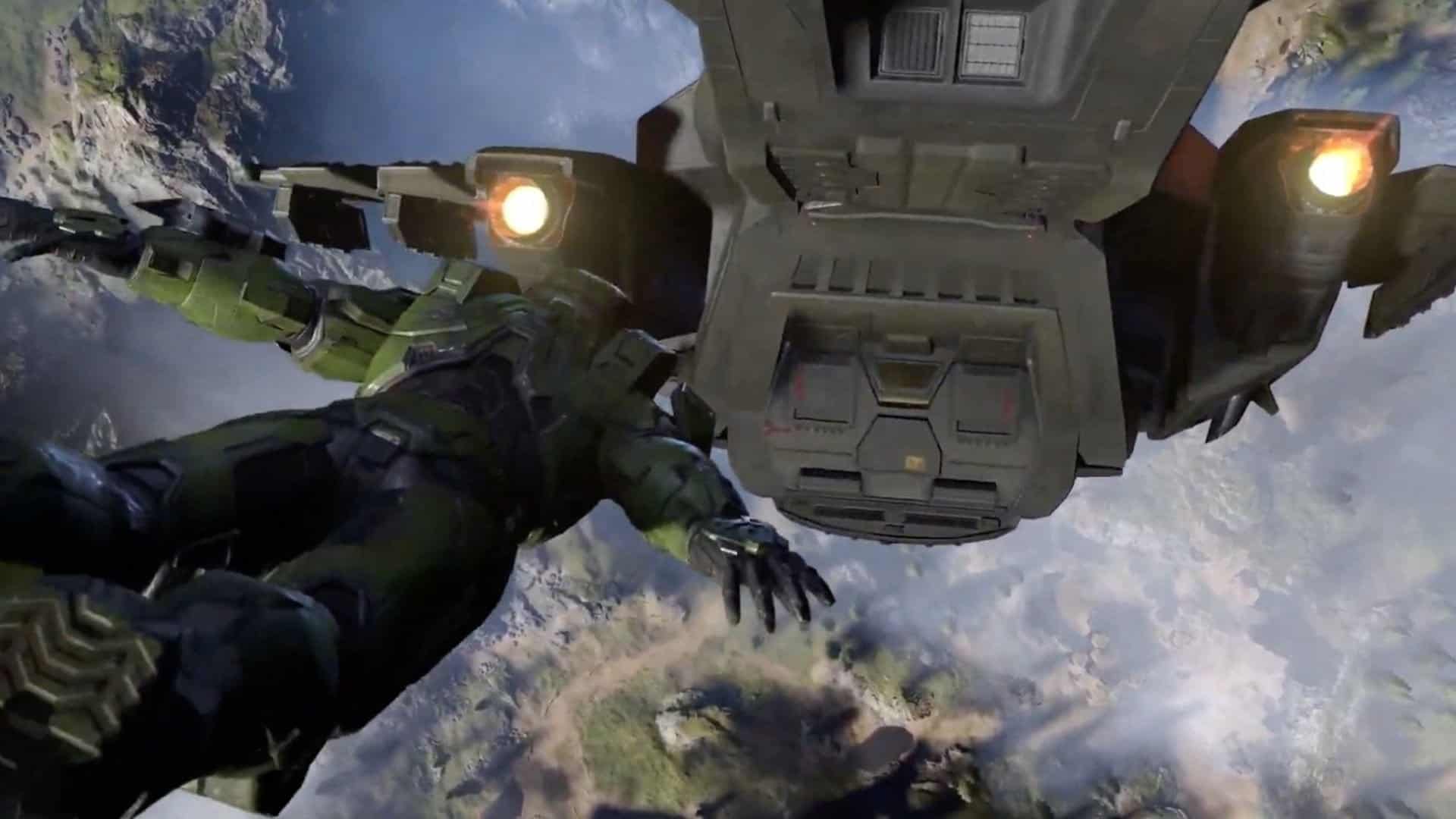You can trust VideoGamer. Our team of gaming experts spend hours testing and reviewing the latest games, to ensure you're reading the most comprehensive guide possible. Rest assured, all imagery and advice is unique and original. Check out how we test and review games here
Good news! The Master Chief is back! Not only that, since we last saw him he has nipped to the salon—or perhaps to the garage—and gotten a new paint job. His suit, in homage to the one in Halo: Combat Evolved, is now the rich hue of pea soup. He has a new companion, in the familiar form of a holographic woman, who likes to stand on his outstretched palm, like Tinkerbell advising one of her Lost Boys. And we find him, in Halo Infinite, on an actual Halo installation—one of the planet-sized metal rings upon which this series was forged, all those years ago. It is a handsome sight: its surface sweeping, mountainous, and furred with trees, its horizon vaulting up into the heavens and back down behind. Poor old Chief. No matter how far he goes, he will always end up where he began.
He happens to begin the new game asleep, drifting through space. He is woken by a bearded and bewildered fellow—a marooned United Nations Space Command pilot, we are told—whose call sign, matching that of his ship, is Echo 216. When our joyless green giant asks to be dropped off at the nearby ring, the better to march into battle, Echo 216 argues, “We need help, not heroics.” In the event, we get a mixture of both. The battle comes courtesy of Escharum, a putty-grey brute with an armoury of fangs and a nasty cough. Escharum leads the Banished, a renegade faction of the series’ longtime alien villains, the Covenant, and he loves regularly popping up, via scratchy orange FaceTime, to torment the Chief.
Meanwhile, scattered across the land are pockets of UNSC forces, along with a number of outposts controlled by the Banished. The Chief’s new A.I. partner—who looks a lot like his old A.I. partner, Cortana, only blue, and who is referred to bluntly as “Weapon”—points to one of these strongholds and says, “It’s well-defended, so it’s definitely worth looking into… and blowing up.” This directive will be familiar to anyone who has played Far Cry. The good news, if you feared the diminution of the Halo formula (hitherto a linear shooter), as it is grafted onto an open world, is that the result is anything but a grind. Indeed, Halo Infinite offers wonders. As far as I can remember, no other sandbox this year has allowed me to drive a UNSC Mongoose (essentially, a quad bike), slewing close to the lip of a cliff while a comrade, perched on the back and toting a rifle, fires wildly at a platoon of gormless foes.
In preparation for this new setting, Master Chief has upped his game. He now has a grappling hook fixed to his wrist, bestowing him with the twanging gifts of Peter Parker; he can yank out-of-reach guns into his hands, zip up onto ledges, or whip towards his enemies like a vengeful trapeze artist. He even has a nifty jet-boosted dodge manoeuvre. It’s as though the developers at 343 Industries had witnessed Doom Eternal and thought, To hell with it! Our viridescent space marine should be just as lavishly gadgeted as that idiot.
The best use for the grappling hook is as a hijacking tool; hitch it to a passing Banshee, for instance, and you will hoist yourself up to its cockpit, relieving its current pilot of his vessel—and, preferably, his life—before screaming off into the clouds. From that vantage, the world is your oyster. Only, it is strung with fewer pearls than its predecessors. The cost of this non-linear battlescape is that 343 has less firm a hand on set pieces. The moments that have defined this series—the drop, at the start of Halo 3: ODST, into the burning streets of New Mombasa; our first encounter with a Covenant Scarab, in Halo 2—were churned and polished in the grip of a tightly controlled narrative. Here you can go where you please. And, while the hillsides crackle with emergent skirmishes, I got to the end of Halo Infinite and found my memory severely underfurnished with vivid scenes.
Another reason for this is the plot, which feels hastily sketched. Major characters and events are alluded to in passing. Escharum, for instance, makes repeated mention of his master, Atriox, the presiding menace of Halo Wars 2, a tactical spin-off; but if you didn’t play that game, it merely sounds as if Escharum were swearing fealty to a brand of gluggable throat medicine. On the other hand, if you did play the last main entry, Halo 5: Guardians, then you may find yourself asking, “What happened to the boring souls of Fireteam Osiris? And where are the Chief’s fellow-Spartans of Blue Team, among them the wonderfully named Linda?”
If the broad emotional strokes of the campaign resonate, it is thanks to Cortana—or, rather, to the traces of her that remain. In Halo 4 (343’s first entry, having taken over from the series’ creator, Bungie) Cortana was blighted by rampancy, a dementia-like condition that rendered her vulnerable to sudden swings of temper and, in Halo 5, turned her into an outright villain. Now she has been vanquished—by who we don’t initially know—and Master Chief keeps hearing her voice. “It’s not her,” says Weapon, who, like Cortana, is also voiced by Jen Taylor, albeit in pluckier tones. “It’s just data,” she says. “Clusters of recursive code.” Even so, her presence vests Halo Infinite with gravity; while the solid details slip its orbit, Cortana pulls us in.
Even so, she is not the object of the game’s fascination. The story, written by Dan Chosich, follows the same path taken by id Software in Doom Eternal; it cannot look away from its green-clad star. Echo 216, exasperated at the Chief’s unflagging efforts, and frustrated at his own human frailty, shouts, “I’m not you.” Yeah, join the club. But who is Master Chief? What abortive sorrows and short-winded elations lurk beneath his Mark VI Mjolnir Powered Assault Armour? Should we really care? The characters in Halo Infinite cue up to either buff his legend or probe the private rooms of his nature. “He’s more of what you might call a man of action,” one of them says. “Why do you do this, again and again?” asks another. And, toward the end: “Everything has gone from me but the certainty of your goodness.” The Master Chief could be the last draftee into the class of true mascots: those whose likenesses have been lofted high above the games that bore them. But I wonder, do Sonic and Mario have to put up with this sort of psychological analysis? And can the Chief bear it out?
Maybe the more intriguing subject—the patient more deserving of such careful examination—is 343 Industries. Is it any wonder that this new ring, designated Zeta Halo, has been partially shattered? If I didn’t know better, I would think the developers were trying to tell us something. Their work has long been tethered to Bungie’s, and their vision has, at times, grown taut and strained. Halo 4 struck me as an intriguing array of ideas, messily presented. By the time Halo 5 came around, however, it was as though 343 had succumbed to rampancy, crowding its action with fragmented characters and diverting into muddy tributaries of plot. With Halo Infinite, the studio seems to want to break the cycle and start afresh. The irony is that it has done so by drawing closer to the past.
Hence the open-world structure, which, armed with the firepower of modern hardware, captures the breathless promise of Combat Evolved, whose clashes were oxygenated by wide-open space. Hence, too, the soundtrack, which, though composed by Gareth Coker, Joel Corelitz, and Curtis Schweitzer, borrow well from Martin O’Donnell and Michael Salvatori, whose orchestral scores for Halo are as good a contender as any for the best the medium has produced. Still, it’s difficult to shake the feeling that these touches are being employed as a calmative—that, after the gruelling confusion of Halo 5, the simple sight of a UNSC Warthog churning through a grassy vale will greet tired eyes like a salve. That may well be the case at first, but after a while a kind of sadness sets in, and 343, like its hero, appears to be haunted by clusters of recursive code. At one point, Weapon, flustered by her host’s determination to improvise, protests, “But this wasn’t the mission.” The answer comes back: “The missions change. They always do.” Not always, Chief.
Where this deference to the old ways is welcome is in the multiplayer, which has crept out, in open beta, before the campaign. Here 343 has honoured the legacy not so much of the Chief but of everyone, slightly silvered by time perhaps, who lived on Xbox Live during his golden years. What is most refreshing about the online multiplayer, if you have arrived from recent games like Call of Duty: Vanguard and Battlefield 2042, is what isn’t here: no perks, no customisable loadouts, no upgraded guns, and, thus, no suspicion that you were just felled by anything remotely unfair. My mood in many online multiplayer shooters is similar to that of Weapon, who, as she and Master Chief alight on Zeta Halo for the first time, says, “Wow. Look at this place. It’s so… Full of more monsters coming to kill us.”
That initial awe, giving way to the pragmatic realisation that one’s end draws near, is instantly recognisable to anyone who has wandered naively into the likes of Apex Legends or Overwatch. In Halo Infinite, every player starts with an assault rifle, a pair of grenades, and a pistol. Better weapons materialise periodically, there for anyone to plunder. And the matches—be they Capture the Flag, Slayer, Total Control, or what have you—are laced sparingly with a delicious compound. And, defeating a team of opposing Spartans, you may, like me, find that you had something they didn’t. Can you guess? Luck.
More than once, I have turned the tide in a match, or killed a superior player, with the chancing toss of a grenade, or the hopefully loosed rocket. The multiplayer in Halo Infinite is a great equalizer; you see everyone leaping through the maps, bound by the same lunar gravity, and you feel free. After the game’s year-long delay, and the fact that it is launching in bits and pieces, it’s a relief to report that the multiplayer is an unreserved joy. Whether it will be the Halo for the next ten years, as has been said, remains to be seen. But it is, right now, where 343 has succeeded with Halo Infinite—where it has taken us full circle and where it is looking ahead. I will leave you with the words of Cortana: “This isn’t an end. It’s a chance to make amends. To rectify mistakes. And it starts here.”
Developer: 343 Industries
Publisher: Xbox Game Studios
Available on: Xbox Series X / S [reviewed on], Xbox One, PC
Release Date: December 8, 2021
To check what a review score means from us, click here.
Halo Infinite
- Platform(s): PC, Xbox One, Xbox Series S/X, Xbox Series X
- Genre(s): Action, Adventure, Shooter





